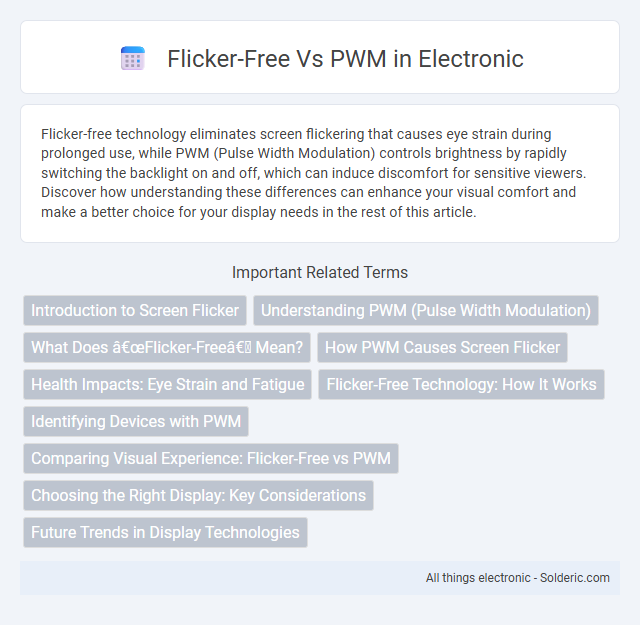Flicker-free technology eliminates screen flickering that causes eye strain during prolonged use, while PWM (Pulse Width Modulation) controls brightness by rapidly switching the backlight on and off, which can induce discomfort for sensitive viewers. Discover how understanding these differences can enhance your visual comfort and make a better choice for your display needs in the rest of this article.
Comparison Table
| Feature | Flicker-Free | PWM (Pulse Width Modulation) |
|---|---|---|
| Definition | Technology that eliminates screen flickering by providing consistent backlight illumination. | Method of dimming screen brightness by rapidly switching the backlight on and off. |
| Eye Strain | Reduces eye strain and fatigue significantly. | May cause eye strain or headaches, especially at low brightness levels. |
| Brightness Adjustment | Maintains stable brightness without flickering. | Brightness controlled by adjusting frequency and duty cycle of pulses. |
| Usage | Preferred for prolonged use and sensitive eyes. | Common in budget monitors and some high-end screens with high PWM frequency. |
| Health Impact | Minimal to no adverse effects on vision. | Potential to cause headaches, eye discomfort, and migraine in sensitive users. |
Introduction to Screen Flicker
Screen flicker refers to the rapid and repeated variation in brightness emitted by a display, often caused by Pulse Width Modulation (PWM) dimming technology. Flicker-Free screens minimize or eliminate this effect by using constant current or alternative dimming methods, reducing eye strain and discomfort during prolonged use. Understanding the difference between Flicker-Free and PWM helps you choose a display that supports better visual comfort and reduces the risk of headaches and fatigue.
Understanding PWM (Pulse Width Modulation)
PWM (Pulse Width Modulation) controls screen brightness by rapidly switching the backlight on and off at different intervals, which can cause noticeable flicker, especially at lower brightness levels. Flicker-free technology avoids this by maintaining a constant brightness level without rapid on-off cycling, reducing eye strain and headaches. Understanding PWM is critical when choosing monitors for prolonged use, as high-frequency PWM flicker is less detectable but still potentially harmful over time.
What Does “Flicker-Free” Mean?
Flicker-free technology eliminates the rapid light intensity changes caused by Pulse Width Modulation (PWM), which can cause eye strain and fatigue during prolonged screen use. Unlike displays using PWM that adjust brightness by flashing backlight at high frequency, flicker-free screens maintain a steady light output, enhancing visual comfort and reducing headaches. Your eyes benefit from flicker-free monitors, especially during extended periods of work or gaming, by minimizing the risk of discomfort associated with screen flicker.
How PWM Causes Screen Flicker
Pulse Width Modulation (PWM) causes screen flicker by rapidly turning the backlight on and off at varying intervals to control brightness, which the human eye can detect as flickering. This flicker occurs because PWM adjusts the duty cycle of the LED backlight, leading to periodic fluctuations in light intensity. Flicker-free technology avoids these fluctuations by using a constant current to maintain steady brightness, reducing eye strain and enhancing viewing comfort.
Health Impacts: Eye Strain and Fatigue
Flicker-Free displays eliminate the rapid on-off cycling caused by Pulse Width Modulation (PWM), reducing eye strain and visual fatigue during prolonged screen use. PWM flickering at high frequencies can cause invisible flicker that leads to headaches, dry eyes, and blurred vision, especially in sensitive users. Choosing Flicker-Free monitors is essential for maintaining eye health and enhancing comfort in environments with extensive screen time.
Flicker-Free Technology: How It Works
Flicker-Free technology reduces eye strain by eliminating the rapid on-off cycling of backlight brightness seen in Pulse Width Modulation (PWM) displays. Instead of controlling brightness through fluctuating light pulses, Flicker-Free monitors use a continuous current to maintain steady luminance. This consistent light output minimizes visual fatigue and enhances viewing comfort during prolonged use.
Identifying Devices with PWM
Devices with PWM (Pulse Width Modulation) use rapid light intensity switching to control brightness, which can cause noticeable flicker especially at lower brightness settings. Identifying such devices involves checking for PWM frequency, often found in product specifications or through specialized testing equipment that detects changes in light output. Understanding if your monitor or screen utilizes PWM helps in choosing flicker-free options to reduce eye strain and improve visual comfort.
Comparing Visual Experience: Flicker-Free vs PWM
Flicker-Free screens reduce eye strain by eliminating rapid light modulation, providing a stable visual experience without noticeable flickering. PWM (Pulse Width Modulation) adjusts screen brightness by cycling the backlight on and off at high frequencies, which can cause flicker perceptible to sensitive viewers, leading to discomfort or headaches. Choosing a flicker-free display enhances your visual comfort during extended use, especially in low-brightness settings.
Choosing the Right Display: Key Considerations
Selecting the right display hinges on understanding flicker-free technology and pulse-width modulation (PWM). Flicker-free screens reduce eye strain by eliminating rapid brightness fluctuations common in PWM-controlled backlights, which can cause headaches and discomfort during prolonged use. Choosing a display with high refresh rates and flicker-free certification ensures optimal visual comfort and reduces potential health risks for extended viewing sessions.
Future Trends in Display Technologies
Future trends in display technologies prioritize flicker-free solutions to enhance visual comfort and reduce eye strain, leveraging DC dimming and advanced LED backlighting techniques. Pulse Width Modulation (PWM) continues to be refined but often causes flicker that affects sensitive users, driving demand for alternative methods. Emerging displays integrate adaptive brightness control and low-flicker tech for improved user experience in smartphones, monitors, and VR devices.
Flicker-Free vs PWM Infographic

 solderic.com
solderic.com